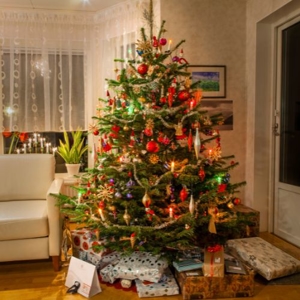
The winter holidays can be the busiest time of year for many households. There are family activities, community events and parties to attend, and you may even be hosting a gathering or two in your own home. Kids are excited, the days are short and there seems to be a never-ending list of things to get done. It’s important to make time to review basic holiday fire safety, including Christmas tree fire safety.
A beautifully decorated Christmas tree is often the focal point of your home’s holiday décor. As gorgeous as your tree and the decorations that adorn it are, it’s critical that they don’t create a Christmas tree fire. According to the National Fire Protection Association (NFPA), home fires occur most often in the winter. The NFPA reports an average of 160 home fires are caused by Christmas trees per year. The fires burn quickly and can destroy more than just the tree, resulting in $10 million in direct property damage annually. Almost one-third of Christmas tree fires are caused by electrical fires.
To keep yourself, your home, and your loved ones safe this holiday season, use these tips from the fire restoration experts at ServiceMaster Restore®.
How To Prevent Christmas Tree Fires
If you prefer decorating your home with an artificial Christmas tree, only purchase one that has been certified and labeled by an independent testing laboratory. If you like the look, smell and appearance of a live tree, there are a few preventative steps you should take. Use these tips to reduce your risk of a Christmas tree fire hazard:
- When choosing a tree, pick one with fresh, green needles that do not fall off when touched.
- Cut about two inches from the base of the trunk before putting the tree in its stand.
- Always keep the tree at least three feet away from any heat source, including candles, heat vents, lights, radiators, and fireplaces.
- Make sure the tree is not blocking any exits.
- Add water to the tree stand daily to help prevent your Christmas tree from getting too dry.
Christmas Tree Safety:
- Live trees need to be fresh and stay fresh until removed from your home. Look for a tree with needles that pull back easily from the branches but don't break. Tap your tree on the ground. If it sheds a ton of needles, it's not fresh.
- Keep a freshly cut tree watered so it doesn't dry out and become a fire hazard. Or, use a potted live tree and plant a memory from this Christmas season to grow for years to come.
- Never place your Christmas tree near a fireplace, wood burning stove or other open flame.
- Never place real, burning candles on your Christmas tree as decorations.
- Christmas trees should not block doorways or exit routes, in case of a fire.
- Only buy fire-resistant artificial trees.
- Inspect all strands of Christmas lights before placing them on your tree. Look for fraying wires and other damage.
- Never use more than three sets of light strands per one extension cord.
- Check all extension cords for damage or fraying; don't overload a single electrical outlet.
- If you're going to be away from home, turn off the Christmas tree lights and consider unplugging all non-essential electronics and appliances.
- Keep lit candle displays at least three feet away from the tree.
- Only decorate a tree with non-combustible or flame-resistant decorations.
How To Safely Use Lights On Your Christmas Tree
Tree lights add ambiance and a bit of magic to your home. However, Christmas tree lights can start a fire if not inspected or used properly. In fact, the NFPA states that electrical distribution or lighting equipment, including decorative lights, wiring, cords, and plugs, were involved in 40 percent of home Christmas tree fires between 2011 and 2015. To help ensure that your Christmas tree lights do not cause any fires, follow these tips:
- Only use lights that have been tested for indoor use by an independent, recognized testing laboratory.
- Do not use lights intended for outdoor use on your Christmas tree.
- Replace any string of lights with worn or broken cords, or with loose bulb connections.
- Read the manufacturer’s instructions to learn how many light strands can be safely connected.
- Check all strands for cracks, frays, and damage before use.
- Do not overload outlets or power strips with Christmas lights and decorations.
- Only use flame-retardant and flame-resistant lights and decorations on your tree.
- Turn off your Christmas tree lights before leaving home or going to bed.
With these tips, you can help prevent holiday decorations from causing significant harm and destruction. Unfortunately, Christmas tree fires aren’t the only common fire hazards in the winter. Use our winter fire safety tips for expert advice on other fire risks that occur during the holiday season. By doing your part now, you can relax and enjoy a stress-free holiday later.
If, despite your best effort, an accident does occur, you don’t need to panic. The professionals at ServiceMaster Restore are available 24/7 every day of the year to help guide you through crisis to resolution. With you as our priority, we work fast to get your home back to normal as quickly as possible, so you can get back to enjoying the holiday season with your loved ones. Learn more about our fire and smoke damage removal services today.


